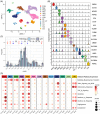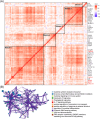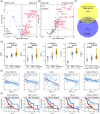An inflammatory cytokine signature predicts IgA nephropathy severity and progression
- PMID: 39492831
- PMCID: PMC11531656
- DOI: 10.1002/mco2.783
An inflammatory cytokine signature predicts IgA nephropathy severity and progression
Abstract
IgA nephropathy (IgAN) is the most prevalent primary glomerulonephritis, resulting in end-stage renal disease and increased mortality rates. Prognostic biomarkers reflecting molecular mechanisms for effective IgAN management are urgently needed. Analysis of kidney single-cell transcriptomic sequencing data demonstrated that IgAN expressed high-expression levels of inflammatory cytokines TNFSF10, TNFSF12, CCL2, CXCL1, and CXCL12 than healthy controls (HCs). We also measured the urine proteins in 120 IgAN (57 stable and 63 progressive) and 32 HCs using the proximity extension assay (PEA), and the multivariable and least absolute shrinkage and selection operator (LASSO) logistic regression analysis both revealed that CXCL12, MCP1 were the prognostic significant variables to predict IgAN progression severity. These two proteins exhibited negative correlation with the estimated glomerular filtration rate (eGFR) and patients with higher expression levels of these two proteins had a higher probability to have poorer renal outcome. We further developed a risk index model utilizing CXCL12, MCP1, and baseline clinical indicators, which achieved an impressive area under the curve (AUC) of 0.896 for prediction of IgAN progression severity. Our study highlights the significance of the inflammatory protein biomarkers for noninvasive prediction of IgAN severity and progression, offering valuable insights for clinical management.
Keywords: IgA nephropathy; Olink Proteomics; prognosis biomarkers; single‐cell sequencing.
© 2024 The Author(s). MedComm published by Sichuan International Medical Exchange & Promotion Association (SCIMEA) and John Wiley & Sons Australia, Ltd.
Conflict of interest statement
The authors declare no conflicts of interest.
Figures





References
-
- Cai GY, Chen XM. Immunoglobulin A nephropathy in China: progress and challenges. Am J Nephrol. 2009;30(3):268‐273. - PubMed
-
- Roberts ISD. Pathology of IgA nephropathy. Nat Rev Nephrol. 2014;10(8):445‐454. - PubMed
-
- Barratt J, Tang SCW. Treatment of IgA nephropathy: evolution over half a century. Semin Nephrol. 2018;38(5):531‐540. - PubMed
-
- Zheng Y, Lu P, Deng Y, et al. Single‐cell transcriptomics reveal immune mechanisms of the onset and progression of IgA nephropathy. Cell Rep. 2020;33(12):108525. - PubMed
LinkOut - more resources
Full Text Sources
Research Materials
Miscellaneous
